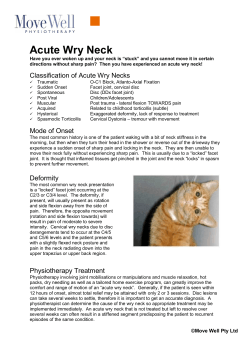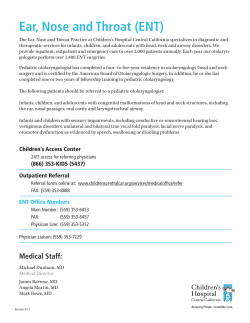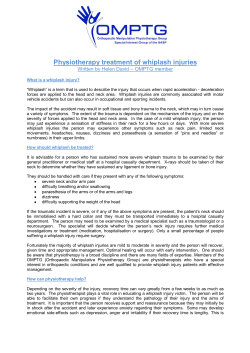
Neck Pain (Cervicalgia) and Torticollis
Page 1 of 6 Neck Pain (Cervicalgia) and Torticollis Neck problems are common in general practice. Neck pain may present as either chronic discomfort, such as with cervical spondylosis, or following acute trauma - eg, whiplash injuries following road traffic accidents. See also separate articles on Cervical Spondylosis and Whiplash and Cervical Spine Injury. Epidemiology [1] Neck pain is one of the most common musculoskeletal complaints. About two thirds of the population will experience neck pain at some point in their lives. Women are affected almost twice as much as men. Prevalence rises with age for men and women and is the highest in the age group between 50-59 years. The incidence of neck pain in general practice has been estimated to be between 18 and 23 per 1,000 registered patients per year. The percentage of people in whom neck pain becomes chronic is generally thought to be about 10%. Causes [2] Nonspecific neck pain: the cause is usually multifactorial and includes poor posture, neck strain, sporting and occupational activities, anxiety and depression. Generalised musculoskeletal problems - eg, rheumatoid arthritis, osteoarthritis, osteoporosis, fibromyalgia. Cervical spondylosis. Cervical intervertebral disc lesions and prolapse. Spinal stenosis. Infection of the spine - eg, osteomyelitis. Bone cancer that involves the spine. Trauma - eg, whiplash. Acute spasm: torticollis (see heading following 'Prognosis', below). Non-musculoskeletal causes - eg, cardiovascular, respiratory and upper gastrointestinal causes, acute upper respiratory tract infections, meningitis. Risk factors Workplace-associated risks: poor workplace design, awkward neck postures, neck flexion, arm posture, duration of sitting, twisting or bending of the body, hand or arm vibration. Excessive use of pillows. Psychosocial factors that may indicate increased risk for chronicity and disability: Excessive concerns about the neck pain. Unrealistic expectations of treatment. Disabling sickness behaviour. Issues of injury compensation. Psychosocial problems, including work or family problems. Presentation See separate articles on Examination of the Spine, Neurological History and Examination, and Neurological Examination of the Upper Limbs. Evaluation of possible causes of neck pain includes an assessment of neurological symptoms and signs in the upper limbs. Spinal cord compression in the neck may lead to lower limb problems and abnormal gait, as well as bladder and bowel disturbance. Page 2 of 6 Nonspecific neck pain Symptoms of nonspecific neck pain vary with different physical activities and over time. It is aggravated by particular movements, posture, and activities, and relieved by others. Pain is often, but not always, aggravated by exercise and relieved by rest. It radiates in a non-segmental distribution into the shoulder, upper back, arm(s) and head. It may be associated with sensory disturbance but there is usually no objective loss of sensation or muscle strength. There may be associated neck stiffness and muscle spasm. It may be associated with dizziness and, much more rarely, with dysphagia, syncope, migraine or chest pain. Typical signs: Positional asymmetry: there may be a change in the most comfortable resting position of the neck or overt torticollis (see heading following 'Prognosis', below). Unequal restriction or limited range of movement (also common with normal ageing). Tenderness of muscles or intervertebral joints is usually poorly localised. Localised nodules or tender bands of increased muscle. Cervical radiculopathy [3] Cervical radiculopathy is usually due to compression or injury to a nerve root in the cervical spine, which may present as pain, motor dysfunction, sensory deficits, or alteration in tendon reflexes. The most common causes are cervical disc herniation and degenerative changes. See also separate articles on Cervical Disc Protrusion and Lesions and Cervical Ribs and Thoracic Outlet Syndrome. Unilateral neck, shoulder, or arm pain that approximates to a dermatome. Altered sensation or weakness in related muscles. Pain or paraesthesia radiating into the arm is not specific for nerve root pain and may be present in people with nonspecific neck pain. Radiculopathy usually affects levels C5 to C7, although higher levels can also be affected. Sensory symptoms are more common than weakness. Reflexes are usually diminished at the appropriate levels. Red flags [2] Red flags are clinical features that indicate an increased risk of specific conditions that can present with neck pain and require urgent attention. Serious underlying cause is more likely: New symptoms before the age of 20 years or after the age of 55 years. Weakness involving more than one myotome or loss of sensation involving more than one dermatome. Intractable or increasing pain. Suggest compression of the spinal cord (myelopathy): Insidious progression. Neurological symptoms: gait disturbance, clumsy or weak hands, or loss of sexual, bladder, or bowel function. Neurological signs: Lhermitte's sign: flexion of the neck causes an electric shock-type sensation that radiates down the spine and into the limbs. Upper motor neuron signs in the lower limbs (Babinski's sign: up-going plantar reflex, hyperreflexia, clonus, spasticity). Lower motor neuron signs in the upper limbs (atrophy, hyporeflexia). Sensory changes are variable, with loss of vibration and joint position sense more evident in the hands than in the feet. Suggest cancer, infection, or inflammation: Malaise, fever, unexplained weight loss. Pain that is increasing, is unremitting, or disturbs sleep. History of inflammatory arthritis, cancer, tuberculosis, immunosuppression, drug abuse, AIDS, or other infection. Lymphadenopathy. Exquisite localised tenderness over a vertebral body. Page 3 of 6 Suggest severe trauma or skeletal injury: A history of violent trauma (eg, a road traffic accident) or a fall from a height. However, minor trauma may fracture the spine in people with osteoporosis. A history of neck surgery. Risk factors for osteoporosis: premature menopause, use of systemic steroids. Suggest vascular insufficiency: Dizziness and blackouts (restriction of vertebral artery) on movement, especially extension of the neck when gazing upwards. Drop attacks. Differential diagnosis Other causes of neck pain and muscle spasm include: Acute disc prolapse: the most common cause of severe secondary torticollis. Tonsillitis, retropharyngeal abscess. Cervical lymphadenopathy due to infection or cancer. Vertebral infection (eg, osteomyelitis). Cervical spine injury (eg, post-traumatic fracture or dislocation). Eye disorders. Dystonia due to any underlying condition - eg, stroke, encephalitis, or cervical dystonia (see 'Cervical dystonia', below). Drug dystonic reactions (eg, antipsychotic drugs, metoclopramide, amfetamines, cocaine). Pseudodystonias - eg, vestibular disorder, tumour of the posterior fossa. Somatisation. Investigations CXRs, and other imaging studies and investigations are not routinely required. Investigations may be required to identify an underlying cause (eg, rheumatoid arthritis) or identify a non-musculoskeletal cause depending on the presentation. Management If any 'red flags' are present, refer the patient urgently for investigations and further assessment. Manage any comorbidities, such as other chronic pain conditions, chronic physical conditions, anxiety, and mood disorders. Specific exercises and multimodal care with mobilisation and/or manipulation plus exercise have been shown to have benefits for mechanical neck disorder with or without headache. [4] [5] There is currently insufficient evidence for or against the efficacy of formal educational interventions, electrotherapy or continuous or intermittent traction for patients with chronic neck disorders. [6] [7] [8] During the first 3-4 weeks (acute phase): [2] Reassure the person that neck pain is very common and the symptoms are likely to resolve. Encourage the person to continue normal activities and discourage prolonged absence from work. Discourage the use of a cervical collar. If used at all, neck supports should only be worn for as short a time as possible (2-4 days) and under supervision (eg, by a physiotherapist). Poor posture should be corrected if it is thought to precipitate or aggravate the neck pain. Advise the person not to drive if the range of motion of the neck is restricted. A firm pillow may provide comfort at night. Offer limited courses of analgesia to relieve symptoms. If symptoms persist from 3 or 4 weeks to 12 weeks (subacute phase), in addition to the above: [2] Refer to a physiotherapist: treatment should include exercise and some form of manual therapy; acupuncture may help. [9] Address any psychosocial factors - eg, fear or avoidance beliefs, associated anxiety and depression, medico-legal issues, family or work problems. Consider referral to a psychologist or occupational health clinician. Page 4 of 6 If symptoms persist for more than 12 weeks (chronic phase), in addition to the above: [2] Continue physiotherapy only if beneficial. Avoid passive interventions, such as massage or electrotherapy. Consider a trial of a low-dose tricyclic antidepressant. Consider referral to a pain clinic. For people with chronic pain, or nerve root symptoms that are poorly controlled, consider referring for assessment for invasive treatment, including surgery. Surgery Surgery may be required for certain causes of neck pain, including vertebral fractures, cervical disc protrusions or lesions, spinal cord injury, or spinal cord compression. Prognosis Acute nonspecific neck pain tends to resolve over a few weeks but may progress into a chronic disabling condition, with periods of remission and exacerbation. Torticollis Torticollis, or wry neck, is a twisted neck. [10] Acute torticollis is thought to be due to minor local musculoskeletal irritation causing pain and spasm in neck muscles. Acute acquired torticollis is common. Torticollis may be congenital (rare) or acquired as a result of many causes, including: After sleeping in an awkward position. Symptoms usually resolve spontaneously within a few days and last no more than 1-2 weeks. Upper respiratory and soft tissue infections of the neck can cause an inflammatory torticollis secondary to muscle contracture or adenitis. Any abnormality or trauma of the cervical spine. Rarely, it also presents as a result of intervertebral disc calcifications, cervical spine tumours, spondylitis, arteriovenous malformations and other bone abnormalities. The cause of torticollis is often not known, but it may be due to bad posture - for example, poor positioning at a computer screen, inappropriate seating, sleeping without adequate neck support, or carrying heavy unbalanced loads (eg, a briefcase or shopping bag). Presentation [11] Sudden onset (often on wakening) of severe unilateral pain with deviation of the neck to that side. The person may experience some premonitory twinges. Occasionally, the pain may be in the middle of the neck. Pain may be referred to the head or shoulder region. The neck feels stuck in one position, and any attempted movement to free it results in sharp spasms of pain. No history of trauma or strain. A history of localised exposure to cold, prolonged or unusual positioning of the neck, or unusual posture (eg, holding the neck in an unusual position whilst working, sleeping, or reading). Signs: Tenderness is usually diffuse on the involved side with palpable spasm. Look for trigger points (tender points of muscle spasm). Check for restricted or painful movement. Visual acuity testing and full eye examination should be considered, especially in children presenting with torticollis. Investigations The diagnosis is clinical and usually no investigations are required. Plain X-rays, CT scans or MRI of the cervical spine may be needed to evaluate for bony trauma, suspected C1-C2 subluxation, congenital bony abnormalities or osteomyelitis. CT scan or MRI of the neck may be useful for evaluation of suspected abscesses, deep space infections, or masses. CT scan or MRI of the brain may be useful to exclude suspected tumours. Page 5 of 6 Management [11] Advise that acute torticollis usually resolves within 24-48 hours. Occasionally, symptoms may take up to a week to resolve and recurrence is common. Advise analgesia, depending on the severity of pain. Also advise gentle exercise, intermittent heat or a cold pack to help reduce pain and spasm, sleeping on a low firm pillow and maintaining a good posture. Causes of torticollis should be identified and treated accordingly. Advise against routine use of a soft cervical collar. Also advise against driving, as it is not possible to rotate the head to view traffic. Prognosis Most cases of torticollis, including congenital muscular torticollis, resolve spontaneously. Cervical dystonia [12] Cervical dystonia (also known as spasmodic torticollis) is a focal dystonia of the neck, which most often occurs in people over the age of 40. Involuntarily contraction of neck muscles produces abnormal movements and postures of the neck and head, which can be twisting (torticollis), being pulled forwards (antecollis), backwards (retrocollis), or sideways (laterocollis). The severity and natural history are very variable in different patients. There is no cure but regular botulinum toxin injections are the most effective treatment. [13] [14] Further reading & references 1. Vos C, Verhagen A, Passchier J, et al; Management of acute neck pain in general practice: a prospective study. Br J Gen Pract. 2007 Jan;57(534):23-8. 2. Neck pain - non-specific; NICE CKS, January 2009 3. Neck pain - cervical radiculopathy; NICE CKS, January 2009 4. Kay TM, Gross A, Goldsmith CH, et al; Exercises for mechanical neck disorders. Cochrane Database Syst Rev. 2012 Aug 15;8:CD004250. doi: 10.1002/14651858.CD004250.pub4. 5. Gross A, Miller J, D'Sylva J, et al; Manipulation or mobilisation for neck pain. Cochrane Database Syst Rev. 2010 Jan 20;(1):CD004249. doi: 10.1002/14651858.CD004249.pub3. 6. Haines T, Gross AR, Burnie S, et al; ACochrane review of patient education for neck pain. Spine J. 2009 Oct;9(10):859-71. Epub 2009 Jul 12. 7. Kroeling P, Gross A, Goldsmith CH, et al; Electrotherapy for neck pain. Cochrane Database Syst Rev. 2009 Oct 7;(4):CD004251. 8. Graham N, Gross A, Goldsmith CH, et al; Mechanical traction for neck pain with or without radiculopathy. Cochrane Database Syst Rev. 2008 Jul 16;(3):CD006408. 9. Witt CM, Jena S, Brinkhaus B, et al; Acupuncture for patients with chronic neck pain. Pain. 2006 Jun 13. 10. Tomczak KK, Rosman NP; Torticollis. J Child Neurol. 2013 Mar;28(3):365-78. doi: 10.1177/0883073812469294. Epub 2012 Dec 26. 11. Neck pain - acute torticollis; NICE CKS, January 2009 12. Patel S, Martino D; Cervical dystonia: from pathophysiology to pharmacotherapy. Behav Neurol. 2013;26(4):275-82. doi: 10.3233/BEN-2012-120270. 13. Costa J, Espirito-Santo C, Borges A, et al; Botulinum toxin type B for cervical dystonia. Cochrane Database Syst Rev. 2005 Jan 25;(1):CD004315. 14. Costa J, Espirito-Santo C, Borges A, et al; Botulinum toxin type Aversus anticholinergics for cervical dystonia. Cochrane Database Syst Rev. 2005 Jan 25;(1):CD004312. Disclaimer: This article is for information only and should not be used for the diagnosis or treatment of medical conditions. EMIS has used all reasonable care in compiling the information but make no warranty as to its accuracy. Consult a doctor or other health care professional for diagnosis and treatment of medical conditions. For details see our conditions. Original Author: Dr Colin Tidy Current Version: Dr Colin Tidy Peer Reviewer: Dr John Cox Last Checked: 07/07/2013 Document ID: 1146 (v24) © EMIS Page 6 of 6 View this article online at www.patient.co.uk/doctor/neck-pain-cervicalgia-and-torticollis. Discuss Neck Pain (Cervicalgia) and Torticollis and find more trusted resources at www.patient.co.uk. EMIS is a trading name of Egton Medical Information Systems Limited.
© Copyright 2025















